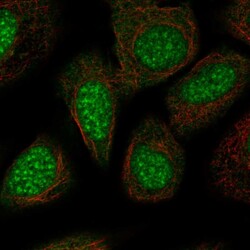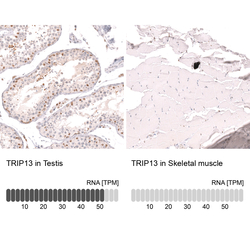Antibody data
- Antibody Data
- Antigen structure
- References [4]
- Comments [0]
- Validations
- Immunocytochemistry [1]
- Immunohistochemistry [1]
Submit
Validation data
Reference
Comment
Report error
- Product number
- HPA005727 - Provider product page

- Provider
- Atlas Antibodies
- Proper citation
- Atlas Antibodies Cat#HPA005727, RRID:AB_10603220
- Product name
- Anti-TRIP13
- Antibody type
- Polyclonal
- Description
- Polyclonal Antibody against Human TRIP13, Gene description: thyroid hormone receptor interactor 13, Alternative Gene Names: 16E1BP, Validated applications: IHC, WB, Uniprot ID: Q15645, Storage: Store at +4°C for short term storage. Long time storage is recommended at -20°C.
- Reactivity
- Human
- Host
- Rabbit
- Conjugate
- Unconjugated
- Isotype
- IgG
- Vial size
- 100 µl
- Concentration
- 0.1 mg/ml
- Storage
- Store at +4°C for short term storage. Long time storage is recommended at -20°C.
- Handling
- The antibody solution should be gently mixed before use.
Submitted references Phosphorylation of TRIP13 at Y56 induces radiation resistance but sensitizes head and neck cancer to cetuximab
Long non-coding RNA NORAD exhaustion represses prostate cancer progression through inhibiting TRIP13 expression via competitively binding to miR-495-3p
Increased expression of TRIP13 drives the tumorigenesis of bladder cancer in association with the EGFR signaling pathway
Translating Proteomic Into Functional Data: An High Mobility Group A1 (HMGA1) Proteomic Signature Has Prognostic Value in Breast Cancer
Banerjee R, Liu M, Bellile E, Schmitd L, Goto M, Hutchinson M, Singh P, Zhang S, Damodaran D, Nyati M, Spector M, Ward B, Wolf G, Casper K, Mierzwa M, D’Silva N
Molecular Therapy 2022;30(1):468-484
Molecular Therapy 2022;30(1):468-484
Long non-coding RNA NORAD exhaustion represses prostate cancer progression through inhibiting TRIP13 expression via competitively binding to miR-495-3p
Chen F, Liu L, Wang S
Cancer Cell International 2020;20(1)
Cancer Cell International 2020;20(1)
Increased expression of TRIP13 drives the tumorigenesis of bladder cancer in association with the EGFR signaling pathway
Gao Y, Liu S, Guo Q, Zhang S, Zhao Y, Wang H, Li T, Gong Y, Wang Y, Zhang T, Dong Z, Bacich D, Chowdhury W, Rodriguez R, Wang Z
International Journal of Biological Sciences 2019;15(7):1488-1499
International Journal of Biological Sciences 2019;15(7):1488-1499
Translating Proteomic Into Functional Data: An High Mobility Group A1 (HMGA1) Proteomic Signature Has Prognostic Value in Breast Cancer
Maurizio E, Wiśniewski J, Ciani Y, Amato A, Arnoldo L, Penzo C, Pegoraro S, Giancotti V, Zambelli A, Piazza S, Manfioletti G, Sgarra R
Molecular & Cellular Proteomics 2016;15(1):109-123
Molecular & Cellular Proteomics 2016;15(1):109-123
No comments: Submit comment
Supportive validation
- Submitted by
- Atlas Antibodies (provider)
- Main image

- Experimental details
- Immunofluorescent staining of human cell line SiHa shows localization to nuclear speckles.
- Sample type
- Human
Supportive validation
- Submitted by
- Atlas Antibodies (provider)
- Enhanced method
- Orthogonal validation
- Main image

- Experimental details
- Immunohistochemistry analysis in human testis and skeletal muscle tissues using HPA005727 antibody. Corresponding TRIP13 RNA-seq data are presented for the same tissues.
- Sample type
- Human
- Protocol
- Protocol
 Explore
Explore Validate
Validate Learn
Learn Western blot
Western blot Immunocytochemistry
Immunocytochemistry